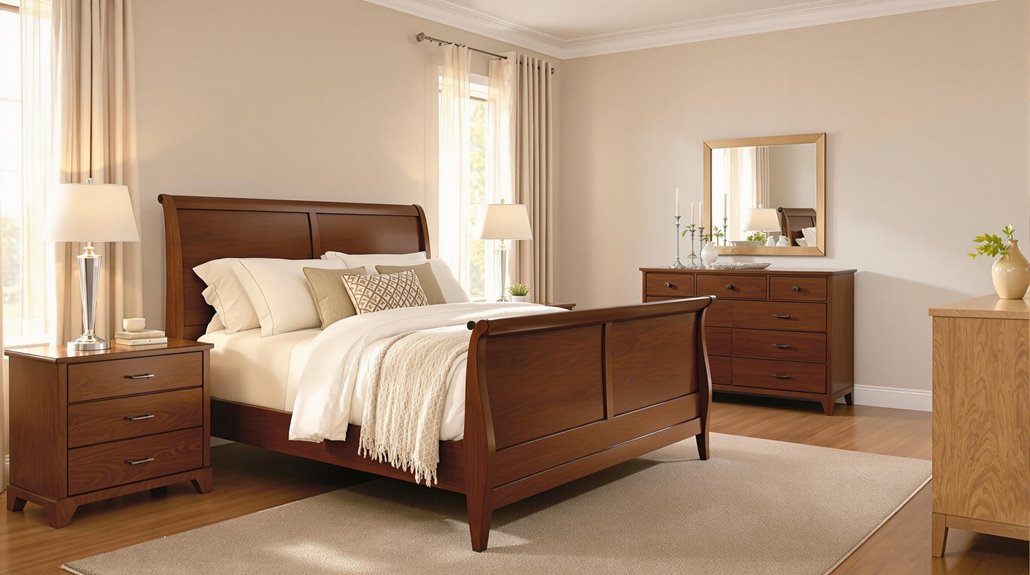The ideal wood for a bedroom typically includes hardwoods such as oak, maple, and walnut due to their exceptional durability, resistance to warping, and aesthetic appeal. These woods not only provide a lasting solution but also feature distinctive grain patterns that enhance the overall design. For a more budget-friendly option, softwoods like pine and cedar offer charm but are less durable. Sustainability should also be considered, with responsibly sourced materials promoting environmental stewardship. Ultimately, evaluating factors such as cost, maintenance, and compatibility with bedroom aesthetics will guide the best choice. Further insights into wood characteristics will aid in making an informed decision.
Durability and Longevity of Woods
When selecting wood for bedroom furniture, understanding the durability and longevity of different types is essential, as this directly impacts both investment value and functional lifespan. Hardwoods, such as oak, maple, and walnut, are known for their exceptional strength and resistance to warping, making them ideal for long-term use. With proper care, solid wood can last a lifetime. In contrast, softwoods, like pine and cedar, are more affordable yet less durable, often prone to warping and cracking. Additionally, specific hardwoods, like teak, excel in humid climates due to their moisture resistance. Ultimately, selecting the appropriate wood species based on performance characteristics guarantees longevity and enhances the overall value of bedroom furniture in varying environmental conditions.
Aesthetic Appeal of Different Woods
The choice of wood for bedroom furniture greatly influences not only its durability but also its aesthetic appeal. Hardwoods such as oak, cherry, and walnut feature distinctive grain patterns that contribute to their natural beauty. Oak showcases prominent, varied grains; cherry offers a straight grain and a rich, reddish-brown hue; while walnut presents a coarse and irregular texture. These woods also come in a spectrum of colors, enhancing the bedroom's ambiance. Softwoods like pine and cedar, with lighter tones and unique grain patterns, impart a casual charm. Both wood types develop character over time, with hardwoods aging into luxurious patinas and softwoods maintaining a consistent aesthetic. Ultimately, the choice of wood impacts the overall atmosphere and elegance of the bedroom space.
Versatility in Bedroom Design
The versatility of wood in bedroom design allows for a seamless integration of various styles, from traditional to modern, catering to diverse aesthetic preferences. This adaptability enables homeowners to achieve a balance between rustic charm and elegant sophistication, accommodating both contemporary trends and timeless elements. In addition, the ability to mix different wood tones and materials enhances the overall design flexibility, making it suitable for any bedroom layout or decor scheme.
Adaptable to Various Styles
While bedroom design often reflects personal style, the choice of wood plays an essential role in achieving versatility across various aesthetics. Maple, with its light color and uniform grain, is ideal for modern and Scandinavian styles and can be stained for a more traditional look. Walnut offers sleek elegance, complementing minimalist designs while seamlessly integrating into eclectic decor through its rich tones and unique patterns. Birch, with its neutral hues, blends well across diverse themes, while pine adds rustic charm, easily merging with modern elements. Additionally, mahogany provides a luxurious touch, enhancing eclectic settings. Each wood type's adaptability allows for personalized expressions, ensuring that bedroom designs can evolve to suit changing tastes and preferences.
Traditional vs. Modern Appeal
Although traditional and modern design styles present distinct aesthetics, both offer unique appeals that can enhance the bedroom experience. Traditional bedroom furniture, characterized by rich woods like walnut and cherry, exudes timeless elegance through ornate carvings and substantial pieces that convey stability. Its durability allows for longevity and adaptability, making it suitable for evolving design preferences. Conversely, modern furniture emphasizes a sleek, minimalist aesthetic, featuring clean lines and neutral tones that create an airy atmosphere. The versatility of modern designs, which can incorporate various wood tones and textures, allows them to complement multiple styles. Ultimately, the choice between traditional and modern wood furniture depends on personal taste, desired ambiance, and the overall design vision for the bedroom.
Rustic Charm vs. Elegance
Balancing rustic charm with elegance offers a unique approach to bedroom design, allowing homeowners to cultivate an inviting yet sophisticated atmosphere. Rustic elements like reclaimed wood and distressed furniture introduce warmth and character, while dark hardwoods and sleek finishes evoke luxury. The strategic use of textures, such as wooden ceilings paired with upholstered furnishings, enriches visual interest and comfort. Color choices play an essential role; warm undertones in wood can create a cozy environment, while neutral tones lend sophistication. Design elements, including simple furniture lines and metal accents, can harmonize rustic and elegant styles. By thoughtfully integrating these features, one can create a bedroom that is both welcoming and refined, showcasing the versatility of wood in contemporary design.
Sustainability and Environmental Impact
Sustainability and environmental impact are critical considerations when selecting wood for bedroom furniture, as responsibly sourced materials can greatly reduce ecological footprints. Utilizing wood from sustainably managed forests or reclaimed sources diminishes the need for virgin timber and supports conservation efforts. Choosing local sources further minimizes carbon emissions associated with transportation. North American hardwoods like cherry, walnut, maple, and oak are excellent choices, particularly when sourced from FSC-certified suppliers, ensuring environmentally responsible practices. Certifications such as E-1 and GREENGUARD indicate low emissions of harmful chemicals, enhancing indoor air quality. Additionally, eco-friendly options like bamboo and red grandis eucalyptus exemplify sustainable alternatives, promoting environmental stewardship. Overall, selecting certified, sustainably harvested wood profoundly impacts climate change mitigation and forest health.
Cost and Value Considerations
When considering the cost and value of wood for a bedroom, it is essential to weigh the initial investment against the longevity of the materials. Solid hardwood, while more expensive upfront, offers durability and the potential for multiple refinishing, making it a long-term asset. Conversely, engineered hardwood presents a more affordable option with lower installation costs, though it may require more frequent replacement, impacting overall value.
Initial Investment Vs Longevity
Choosing the right flooring for a bedroom involves weighing the initial investment against the longevity and overall value it brings. Hardwood flooring, while costing $5 to $10 per square foot initially, can last for decades and greatly increase home value. In contrast, laminate and vinyl options, ranging from $0.50 to $5 per square foot, offer shorter lifespans of 10 to 20 years and generally do not enhance property value as much. Tile flooring presents a mixed scenario; while it can endure for 50 years or more, its installation costs can be high. Ultimately, the choice depends on balancing upfront costs with the expected lifespan and potential return on investment, ensuring long-term satisfaction and value.
Affordable Wood Options
Numerous affordable wood options are available for bedroom projects, providing cost-effective solutions without sacrificing quality or aesthetics. Ash and soft maple are popular choices, offering beautiful finishes at low prices, typically around $2 per board foot. Hickory, although requiring more work, is available for about $1.37 per board foot, making it a durable option. Additionally, red elm and red gum present unique grain patterns at reasonable costs, enhancing visual appeal. For softer woods, pine and cedar are budget-friendly options, with cedar's natural resistance to moisture making it versatile for various applications. Knotty alder and Spanish cedar also provide low-cost alternatives, ensuring that affordability does not compromise the overall integrity and style of bedroom furniture.
Maintenance and Care Tips
To guarantee the longevity and beauty of wooden furniture in your bedroom, regular maintenance and care are essential. Dust your wood furniture at least once a week with a soft, lint-free cloth, slightly dampened with warm water and mild dish soap, always cleaning in the direction of the grain. Protect your furniture from heat sources and direct sunlight, maintaining humidity levels between 40 and 45 percent to prevent drying or shrinking. Avoid placing hot or sharp objects directly on wood surfaces; use felt pads and coasters for protection. Additionally, polish the wood monthly with a quality, wax-based product, steering clear of silicone and oil-based options. Finally, ascertain the wood is thoroughly dried after cleaning to prevent mold growth.

